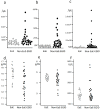Review of Non-Eosinophilic Esophagitis-Eosinophilic Gastrointestinal Disease (Non-EoE-EGID) and a Case Series of Twenty-Eight Affected Patients
- PMID: 37759817
- PMCID: PMC10526434
- DOI: 10.3390/biom13091417
Review of Non-Eosinophilic Esophagitis-Eosinophilic Gastrointestinal Disease (Non-EoE-EGID) and a Case Series of Twenty-Eight Affected Patients
Abstract
Eosinophilic gastrointestinal disease (EGID) is divided into eosinophilic esophagitis (EoE) and non-eosinophilic esophagitis eosinophilic gastrointestinal disease (non-EoE-EGID) based on the involved gastrointestinal segments. Reports regarding non-EoE-EGID are limited, in part because of its rarity. The present study was performed to review non-EoE-EGID, including its pathogenesis, diagnosis, treatment, and prognosis. Additionally, details regarding 28 cases of non-EoE-EGID recently diagnosed at our Japanese tertial medical center are presented and compared with 20 EoE cases diagnosed during the same period at the same medical center. Comparisons of the two groups clarified differences regarding age- and gender-dependent prevalence between the two conditions, and also showed that systemic involvement and disease severity were greater in the non-EoE-EGID patients. Notably, diagnosis of non-EoE-EGID is difficult because of its lack of specific or characteristic symptoms and endoscopic findings. The clinical characteristics of EoE and non-EoE-EGID differ in many ways, while they also share several genetic, clinical, laboratory, and histopathological features.
Keywords: allergy; eosinophil; esophagus; functional dyspepsia; gastrointestinal tract; irritable bowel syndrome.
Conflict of interest statement
The authors have no COIs concerning this manuscript.
Figures






Similar articles
-
Questionnaire Survey on the Diagnosis and Treatments of Eosinophilic Gastrointestinal Diseases in Asia.Digestion. 2025;106(2):153-164. doi: 10.1159/000544725. Epub 2025 Feb 13. Digestion. 2025. PMID: 39947169
-
Segmental overlap is common in eosinophilic gastrointestinal diseases and impacts clinical presentation and treatment.Dis Esophagus. 2025 Jan 7;38(1):doaf011. doi: 10.1093/dote/doaf011. Dis Esophagus. 2025. PMID: 40036388 Free PMC article.
-
Primary Eosinophilic Gastrointestinal Diseases Beyond Eosinophilic Esophagitis in Children.J Pediatr Gastroenterol Nutr. 2021 Feb 1;72(2):294-299. doi: 10.1097/MPG.0000000000002925. J Pediatr Gastroenterol Nutr. 2021. PMID: 32868666
-
Eosinophilic Gastrointestinal Diseases in Childhood.Ann Nutr Metab. 2018;73 Suppl 4:18-28. doi: 10.1159/000493668. Epub 2019 Feb 19. Ann Nutr Metab. 2018. PMID: 30783041 Review.
-
Endoscopic Features of Eosinophilic Gastrointestinal Diseases.Immunol Allergy Clin North Am. 2024 May;44(2):357-368. doi: 10.1016/j.iac.2024.01.007. Epub 2024 Feb 13. Immunol Allergy Clin North Am. 2024. PMID: 38575229 Free PMC article. Review.
Cited by
-
Advances in Biologic Therapies for Allergic Diseases: Current Trends, Emerging Agents, and Future Perspectives.J Clin Med. 2025 Feb 8;14(4):1079. doi: 10.3390/jcm14041079. J Clin Med. 2025. PMID: 40004611 Free PMC article. Review.
-
Prevalence and Distribution of Gastric Endoscopy Findings in Non-eosinophilic Esophagitis Eosinophilic Gastrointestinal Diseases: Influence of Atrophic Gastritis.Intern Med. 2025 Apr 15;64(8):1161-1170. doi: 10.2169/internalmedicine.4193-24. Epub 2024 Sep 11. Intern Med. 2025. PMID: 39261065 Free PMC article.
-
Uncommon Coexistence of Eosinophilic Colitis, Asthma, and Elevated IgG4 Levels: A Case Report.Int Med Case Rep J. 2024 Nov 7;17:939-943. doi: 10.2147/IMCRJ.S482180. eCollection 2024. Int Med Case Rep J. 2024. PMID: 39529698 Free PMC article.
-
The Dual Lens of Endoscopy and Histology in the Diagnosis and Management of Eosinophilic Gastrointestinal Disorders-A Comprehensive Review.Diagnostics (Basel). 2024 Apr 22;14(8):858. doi: 10.3390/diagnostics14080858. Diagnostics (Basel). 2024. PMID: 38667503 Free PMC article. Review.
-
Food protein-induced enteropathy: a revision for the clinician.Front Pediatr. 2024 Sep 10;12:1417391. doi: 10.3389/fped.2024.1417391. eCollection 2024. Front Pediatr. 2024. PMID: 39318619 Free PMC article. Review.
References
-
- Dellon E.S., Gonsalves N., Abonia J.P., Alexander J.A., Arva N.C., Atkins D., Attwood S.E., Auth M.K.H., Bailey D.D., Biederman L., et al. International Consensus Recommendations for Eosinophilic Gastrointestinal Disease Nomenclature. Clin. Gastroenterol. Hepatol. 2022;20:2474–2484.e3. doi: 10.1016/j.cgh.2022.02.017. - DOI - PMC - PubMed
-
- Shoda T., Collins M.H., Rochman M., Wen T., Caldwell J.M., Mack L.E., Osswald G.A., Besse J.A., Haberman Y., Aceves S.S., et al. Evaluating Eosinophilic Colitis as a Unique Disease Using Colonic Molecular Profiles: A Multi-Site Study. Gastroenterology. 2022;162:1635–1649. doi: 10.1053/j.gastro.2022.01.022. - DOI - PMC - PubMed
-
- Spergel J.M., Book W.M., Mays E., Song L., Shah S.S., Talley N.J., Bonis P.A. Variation in prevalence, diagnostic criteria, and initial management options for eosinophilic gastrointestinal diseases in the United States. J. Pediatr. Gastroenterol. Nutr. 2011;52:300–306. doi: 10.1097/MPG.0b013e3181eb5a9f. - DOI - PMC - PubMed
Publication types
MeSH terms
Supplementary concepts
LinkOut - more resources
Full Text Sources
Medical

